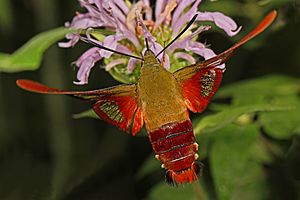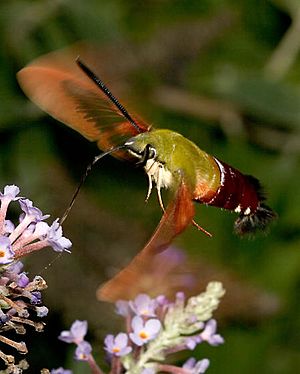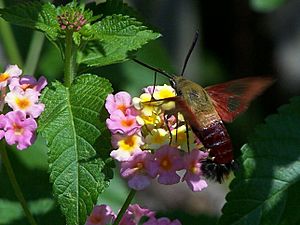Hummingbird clearwing facts for kids
Quick facts for kids Hummingbird clearwing |
|
|---|---|
 |
|
| Feeding adult | |
| Scientific classification | |
| Genus: |
Hemaris
|
| Species: |
thysbe
|
| Synonyms | |
|
|
The hummingbird clearwing (scientific name: Hemaris thysbe) is a type of moth from the Sphingidae family, also known as hawkmoths. This amazing moth looks a lot like a hummingbird or a bumblebee! It flies very fast and hovers over flowers to drink nectar.
Hummingbird clearwings have different colors, but they are usually olive green and burgundy on their backs. Their undersides are often white or yellow and burgundy. Their wings are mostly clear, with a reddish-brown border. They also have light-colored legs.
You can find the hummingbird clearwing moth across a large part of North America. They live from Alaska all the way to Florida. These moths are migratory, meaning they travel long distances. They are most common in southern Ontario and the eastern United States.
Contents
What Does It Look Like?
The adult hummingbird clearwing moth has a body shaped like a spindle, which is wider in the middle and tapers at the ends. Its body is covered in thick fur. The colors can be different from one moth to another.
Usually, the top part of the moth's body (called the thorax) is olive to golden-olive. Its belly area (called the abdomen) is burgundy to black, with lighter olive or golden patches. The underside of the moth is white or yellow on the thorax and burgundy or black on the abdomen.
When a hummingbird clearwing moth first comes out, its wings are dark red or black. As it starts to fly, tiny scales fall off its wings. This leaves the wings mostly clear, with reddish-brown edges and veins. The shape of the border and the pattern of the veins can be different for each moth.
These moths beat their wings very quickly. Their wingspan is about 4 to 5.5 centimeters (1.6 to 2.2 inches). They have light-colored legs, which are often yellow. Moths from warmer southern areas or those born later in the year tend to be darker in color. Moths from the south and east usually have jagged wing borders, while northern and western ones often have smooth borders.
The antennae of the hummingbird clearwing moth are thicker at the bottom and curve at the ends. Unlike most moths, this species cannot hear. It has compound eyes, which are eyes made of many small lenses.
You can tell the hummingbird clearwing apart from similar moths like the slender clearwing and the snowberry clearwing. The hummingbird clearwing has no stripes on the underside of its thorax and has pale legs. The slender clearwing has reddish legs, and the snowberry clearwing has black legs.
Life Cycle and Habits
The caterpillar of the hummingbird clearwing moth is yellowish-green. It has dark green and reddish-brown bands. Its body is bumpy with small white spots, and it has a white horn sticking out from its back end.
As a caterpillar, H. thysbe eats leaves from plants like cherry trees, European cranberry bush, hawthorns, dogbane, honeysuckle, and snowberry.
When it's time to change, the caterpillar burrows into the soil. It forms a brown, hard-shelled pupa and stays there through the winter. In late spring, an adult moth emerges from the pupa.
The adult moth lays green eggs on the underside of plant leaves. These eggs hatch in about one week. The caterpillar grows for about four weeks. After this, it spins a cocoon on the ground. Two to four weeks later, a new moth comes out. In warmer southern areas, these moths can have a second breeding cycle before summer ends. In colder northern areas, they usually only have one breeding cycle per year.
Hummingbird clearwing moths are most active during the hottest parts of the day. They stay active until sunset. They collect nectar from many different flowers using a long tube-like mouthpart called a proboscis. This proboscis is about 19 to 21 millimeters (0.75 to 0.83 inches) long. They hover above the flowers while feeding. They seem to prefer pink and purple flowers and move quickly from one flower to the next.
Where They Live
The hummingbird clearwing moth lives in second-growth forests and meadows. You can also often find them in gardens in towns and cities.
These moths are migratory, which means they can travel very far. In areas where they have only one group of babies (brood) per year, you can see adults throughout the summer. In the southern parts of their range, adults are present from March to June and again from August to October.
H. thysbe is most common in the eastern United States and southern Ontario. Its range stretches east to Newfoundland and west to Texas, the Great Plains, and into Manitoba, Saskatchewan, and Alberta in Canada. On the west coast of North America, they live from Oregon up to the Yukon Territory and Alaska.
These moths are not harmful to humans or crops. In fact, they help pollinate many cultivated flowers. They are even the main pollinator for some types of orchids. The hummingbird clearwing moth is not an endangered or threatened species.
How It Got Its Name
The hummingbird clearwing moth was first described by a scientist named Johan Christian Fabricius in 1775. He named it Sesia thysbe. The name thysbe probably comes from Thisbe, a character in an old story by Ovid called Metamorphoses. In the story, Thisbe's scarf gets stained with blood. This name connects the reddish-brown color of the moth to the blood-stained scarf in the story.
Because the hummingbird clearwing moth can look so different in color and wing patterns, scientists in the 1800s often thought they were many different species. But in 1971, an entomologist (a scientist who studies insects) named Ronald Hodges studied them closely. He found that even though they looked different, their bodies were the same inside. He realized that all these different-looking moths were actually just one species.
Images for kids
See also
 In Spanish: Hemaris thysbe para niños
In Spanish: Hemaris thysbe para niños







